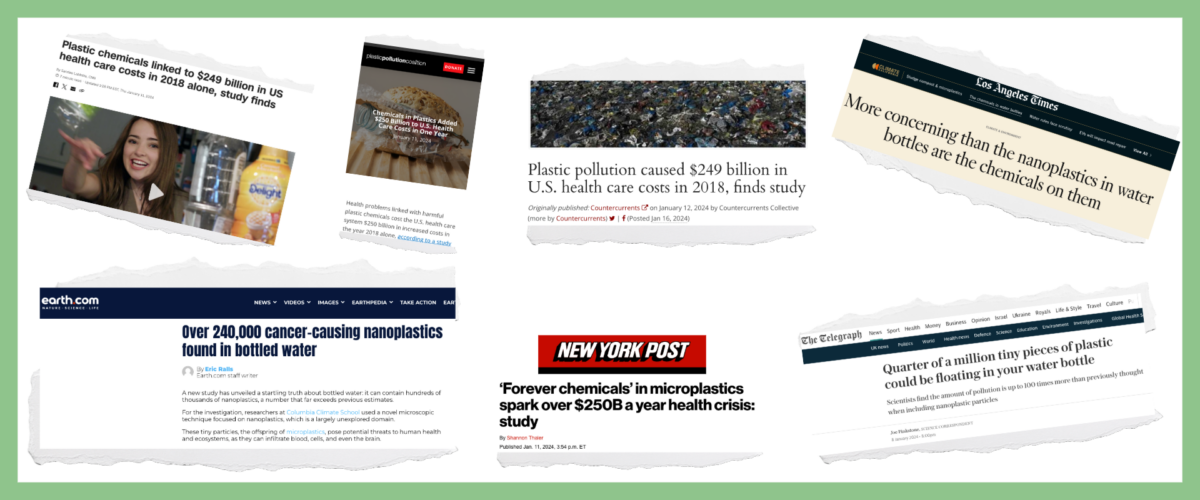
There’s been A LOT in the news this month about microplastics and nanoplastics and their worrying human health implications. It can often feel overwhelming when we read articles on what the plastic crisis is doing to our health, but the good news is that our own exposure levels to these things are largely within our control. There is a lot we can do to significantly reduce the microplastics and nanoplastics in our own homes and reduce the chemical load on our families.
Firstly, you might be wondering why there is so much in the news on this topic at the moment. This is down to two really important and recently published studies in America which give us more information and data about our exposure to these toxins and the health consequences of microplastics and the chemicals used in plastic. In the short article below we summarise what we feel are the key points from these studies – as always, we’ve waded through the paperwork and broken it down for you in easy to digest terms (there’s a lot of technical jargon in the research reports which can make them quite dry reading!). And most importantly, we give some simple tips on how to minimise your family’s exposure.
Key points from the recent studies on microplastics, nanoplastics and the plastic related disease burden:
- Between 110,000-370,000 plastic particles per litre were detected in bottled water (tested on three popular water brands based in America)
- 90% of the above particles were nanoplastics, the remaining 10% were microplastics
- Nanoplastics are thought to be a bigger health concern than microplastics as their small size enables them to cross biological barriers
- Nanoplastics can easily enter our bloodstream, where they are passed around our bodies and deposited in major organs including our brains, lungs, hearts and even our cells
- PET (used to make polyester) and nylon were the most commonly found plastic particles in the bottled water tested
- Plastic related disease are estimated to have cost the US healthcare system US$249 billion in 2018 alone, due to the toxic chemicals used to make plastics
- Sadly, the vast majority of this disease burden was found to impact the prenatal category, contributing to IQ loss, intelectual disability, testicular cancer, low birth weight and childhood obesity, among other things
- Chemicals of particular concern include BPA (bisphenols), PFAS (‘forever chemicals’) and pthalates (plasticisers)
- Conclusions from New York University were that “plastics contribute substantially to disease and associated social costs in the United States, accounting for 1.22% of the gross domestic product. The costs of plastic pollution will continue to accumulate as long as exposures continue at current levels.”
- Further studies into nanoplastics are currently ongoing, including doctors and professors looking at the release of nanoplastics when we do laundry and looking at nanoplastics in various human tissues, as well as the associated developmental and neurological effects of this. (see here for our quick home experiment on how many micro particles are given off into our indoor air each time we do laundry).
How to significantly limit your family’s exposure to microplastics and nanoplastics

The above may seem scary, but it’s important to remember that a lot of our exposure to these plastics happens in our own homes, and therefore is within our control. Knowledge is power and there is so much we can do to quickly and easily limit our family’s exposure to these toxins. We’ve outlined our top tips below, but you can find lots more information and great tips on our #PlasticFreeBabies page here.
- Remove or significantly reduce synthetic fabrics and textiles from your house. Start with anything your children are in regular contact with, like clothing, teddies, toys, kitchenwear, rugs and cushions. Start small, it can be a daunting task but every change you make will make a huge difference.
- Drink filtered tap water. Tap water has been shown to contain significantly fewer microplastics than bottled water, and filtering your tap water removes even more.
- Don’t dry laundry in your kitchen. When fabrics are touched, shaken or disturbed they give off thousands of micro particles. If any of these fabrics are synthetic these micro particles will be micro and nanoplastics, which will release into the air and settle in food and on kitchen surfaces.
- Hoover and dust as regularly as you can. This will reduce the microplastic buildup in your homes.
- Choose toys made from natural and organic materials. Toys are often sucked on and shaken around, which exposes little ones to significant levels of microplastics (if these toys are synthetic).
For more information on the effects of micro and nanoplastics and their associated chemicals on mammals please see this article, published on Frontiers.
Pure Earth Collection are passionate about creating safer, non-toxic and biodegradable children’s products. To discover lots of lovely children’s brands making plastic-free and low toxic products check out our Conscious Brand Directory here. And to shop our range of plastic-free children’s products click below.
Sources:
Rapid single-particle chemical imaging of nanoplastics by SRS microscopy: https://www.pnas.org/doi/10.1073/pnas.2300582121
University of Colombia and Rutgers study on nanoplastics in bottled water: https://www.publichealth.columbia.edu/news/bottled-water-can-contain-hundreds-thousands-nanoplastics
New York University’s estimated health costs: https://academic.oup.com/jes/article/8/2/bvad163/7513992
https://www.publichealth.columbia.edu/news/bottled-water-can-contain-hundreds-thousands-nanoplastics
